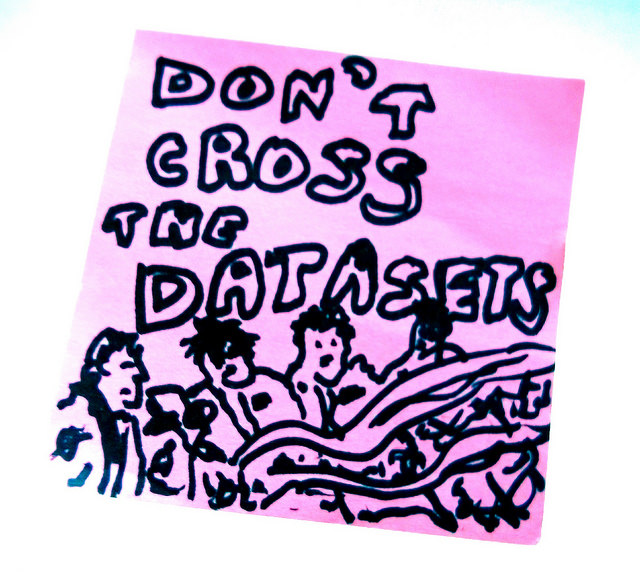|
|
|
Archive for February, 2019
Tuesday, February 12th, 2019
 Have you ever wondered why bias is so deeply ingrained and prevalent? Have you ever wondered why bias is so deeply ingrained and prevalent?
The answer is simple.
The datasets are biased.
For humans
Psychologists from Northwestern University have found that children as young as four show signs of racial bias, suggesting they pick up on cues to act intolerant from the adults around them from a very early age.
For AI.
The digital world is an incredibly biased place. Geographically, linguistically, demographically, economically and culturally, the technological revolution has skewed heavily towards a small number of very economically privileged slices of society.
Knowing the datasets for both are biased for the same reason, it is the wise boss, from team leader to CEO, who takes time to learn their own biases and also understand the various biases of their team.
Only then can they develop approaches and work-arounds.
The bottom line in business is that you don’t have to change minds, you just have to create processes that neutralize the effects.
Image credit: Paul Downey
Posted in Culture, Ducks In A Row, Personal Growth | No Comments »
Monday, February 11th, 2019

Poking through 12+ years of posts I find information that’s as useful now as when it was written.
Golden Oldies is a collection of the most relevant and timeless posts during that time.
Trust is a funny thing. We don’t usually ask ourselves if we trust someone when we initially meet. Often, the only reason we start thinking consciously about whether we trust them is because some action of theirs felt untrustworthy. We may not even be able to identify what it was; just a niggling discomfort that makes us squirm a bit.
We would all be wise to pay attention to the niggle.
Although too often we blow it off and go our merry way.
Read other Golden Oldies here.
No matter the medium you use to follow the news a large proportion of the stories have a trust angle—most with a negative look at who/how/why it was broken.
I tend to trust people with good diction because I can hear what they say; others trust people because of perceived commonality—the same place of worship, similar political stances, the same schools, military service, mutual connections, etc.
When you see it written down like that the idiocy of any commonality as a basis for trust is apparent, but on any day you can find stories about broken trust that was based on these and similar ephemeral reasons (such as diction). Possibly one of the dumbest is the trust based on some form of online friendship at places such as Facebook.
Even trust in introductions made by long time friends can be misplaced as the experience of my friend Kelly shows.
Briefly, her friend arranged a blind date for Kelly with a guy she knew. She didn’t mention that she had only chatted for a few minutes with him during a conference; she thought he was cute and that Kelly would like him.
Fortunately for Kelly he was arrested two days before their date—charged with attempted rape. Her friend was shocked because he was well dressed and it was a professional conference, so she assumed he was OK.
There are thousands of similar stories out there; many with much worse endings.
So how do you know who to trust?
When I was looking for quotes about trust for yesterday’s post I found an anonymous one that offers some excellent guidance.
“The key is to get to know people and trust them to be who they are. Instead, we trust people to be who we want them to be- and when they’re not, we cry.”
Getting to know someone takes time, but you can pursue a dual track by giving the people the benefit of the doubt if your guts says yes, while maintaining a vigilant watch to make sure that their actions are consistent with their expressed MAP (mindset, attitude, philosophy™) and being ruthless in not rationalizing away the inconsistencies.
Image credit: Vic
Posted in Golden Oldies, Personal Growth | No Comments »
Friday, February 8th, 2019

A Friday series exploring Startups and the people who make them go. Read all If the Shoe Fits posts here.
I love the story of startup Be My Eyes, because it highlights an entrepreneur who really is changing the world and illustrates the good that comes from a lack of funds.
I read the story in the Lean Startup blog and thought it worth sharing.
“Be My Eyes is just a simple app that basically makes a video call between two persons (…) we have volunteers who sign up and say ‘Yes, I am available to help a blind person see something.’”
The volunteer presence adds an extra layer of independence to the visually impaired person’s life, rather than worrying that they are interrupting or imposing on someone.
All the volunteers do it look at their screen and tell the caller what they see, such as the ingredients in a recipe.
Be My Eyes boasts a global network of volunteers speaking a variety of languages and is always recruiting more.
The great thing is the volunteers can respond from wherever they are and the calls only take a few minutes. If they can’t take the call, no problem, since the system calls multiple people for each request.
Be My Eyes has a number of programs to encourage company involvement, including a way to provide product support to vision impaired/blind customers. This is a great opportunity for startups that want to give back, but have neither time or money to donate.
As to the advantage of minimal funding, it kept them from the typical tech error of over-engineering and forced them to keep the app very simple. Good move.
They had an overly long list of features they wanted to put into the app in the beginning, but which lack of funds prevented. (…) Be My Eyes hasn’t had many requests for all the “brilliant ideas” they had in the beginning. “So maybe it was a really good thing we didn’t overload the app.”
Be it as an individual or involving your family, friends or company be someone’s eyes, you’ll be amazed at the difference doing so will make in your life, as well as theirs.
Image credit: HikingArtist
Posted in Entrepreneurs, If the Shoe Fits, Innovation, Role Models | No Comments »
Thursday, February 7th, 2019

Yea! Ryan’s back.
At my work we recently had an abrupt leave of absence for an employee that I have great respect for. Our CEO pushed out a statement asking that we respect that employee’s privacy during this time and that we look forward to the person coming back to work.
If I am judging the email correctly it seems our CEO was being genuine in his hope that the employee comes back soon and on better ground.
I do not know the details of the abrupt leave of absence, however, I know the employee well enough to suspect something went on personally that needed to be prioritized.
For some reason, that person’s story made me think of new beginnings.
Essentially, our company is hoping for a new beginning for that employee.
Of course we hope for new beginnings in our own lives as well. We set up goals for the new year, pin up vision boards or welcome new additions.
My wife and I did the latter. We welcomed a baby boy this past month with the hopes and dreams of a future generation.
I have four children now, he is our grand finale baby, and I never tire of my hope and love for them.
I struggled when I first had children on how I would divide my love with more than just my wife.
The good news is there does not seem to be any shortage, it just multiplies with each child.
The hope you feel with a new beginning multiplies as well.
Why do we look at newness with such hope? Is it because it is a fresh page to write a future on? Are we free of mistakes and faults when new? Does the potential of things to come inspire us?
For me. I love the choice that is laid out.
My children have a choice to shape their life as they see fit.
And they may be in a position to one day to grant an abrupt leave of absence to an employee in need.
They will hope for new beginnings as well and I cannot wait to see what happens.
Image credit: Pacific Southwest Region 5
Posted in Personal Growth, Ryan's Journal | No Comments »
Wednesday, February 6th, 2019

One of the major reasons people ghost isn’t rocket science.
Nor is the major cause.
Candidates ghost because nothing connected — not the company, culture, job, people, and especially not the hiring manager.
Employees ghost because they aren’t engaged.
They feel that nobody — boss, company, colleagues — gives a damn so why should they.
And in many cases they are correct.
Companies don’t walk their cultural talk, low morale is obvious, as is a “me before thee” attitude, and
for a variety of reasons, bosses treat people as replaceable — even when they know it won’t be easy or could take months.
It’s nothing new.
Since the day people became hires, instead of slaves or indentured, bosses have used and abused them.
They still do, but on a more refined level.
Skipped promotions, demotions with little-to-no explanation, seriously brutal layoffs by email, with no warning (as Elon Musk just did), which is especially destructive to people when the company/job has been cast as some kind of “higher calling,” as is common in the tech world.
Candidates often fare no better.
Many managers consider hiring a necessary evil — resumes bore them, they hate wasting time interviewing — and they have more important things to do.
Strangely enough, HR often acts the same way, with preliminary interviews conducted by interviewers who look for word matches between resumes/candidates and job descriptions.
Obviously, it’s not all companies or all bosses — but likely the ones that get ghosted.
Image credit: Joe Le Merou
Posted in Communication, Culture, Hiring, Motivation, Retention | No Comments »
Tuesday, February 5th, 2019

Two facts
- Google hires a lot of people
- Google is very good at algorithms
So why not use the latter to solve the former?
It doesn’t work.
Google is known for hiring really smart people, so why not use brain teaser questions to identify them.
It doesn’t work.
Analytics can make a difference if your company is large enough.
AI may help, but its bias, the result of biased data sets, means a high cost in missed candidates.
It also means more time to hire and more money spent, because you will be chasing the same people as everyone else.
Like it or not, your staffing is dependent on the hiring skills of your managers.
There is no staffing gene; people aren’t born knowing how to hire anymore than they are born knowing how to manage.
It’s your responsibility to make sure they learn both.
Image credit: Otota DANA
Posted in Ducks In A Row, Hiring | No Comments »
Monday, February 4th, 2019

Poking through 12+ years of posts I find information that’s as useful now as when it was written.
Golden Oldies is a collection of the most relevant and timeless posts during that time.
I read an interesting article from Wharton on the current trend of ghosting by both candidates and employees (more on that later in the week). Today’s Oldies are kind of the yin and yang of finding and keeping people who aren’t likely to ghost.
Read other Golden Oldies here.
Talent in good times and bad (2008)
The people market is tightening (again), and the pundits are arguing (again) over whether there actually is a shortage of qualified people to fill openings across industries, especially high tech.
Is there really a shortage? Does it matter?
If there is a perceived shortage (i.e., jobs aren’t being filled), then companies will continue to fret over finding qualified people and managers will continue to worry that a lack of talent will damage their own careers.
During the most recent downturn there was an abundance of talent available as has happened in the past; for example
- The early nineties, when a typical ad for a software engineer in Silicon Valley drew 100-plus viable responses.
- Post-October 1987, when a financial services ad would easily draw five hundred qualified responses.
- The early seventies, when an ad for a microwave designer ran in the Sunday San Jose Mercury and over three hundred qualified engineers started lining up at 6 AM Monday morning to wait for the company’s doors to open.
It is neither the surplus of talent in a down market, nor the dearth of it in a tight market, that creates a staffing problem. Rather it is the attitude of many managers that if the person is not already working there must be something wrong.
In the Eighties the thought was “There must be something wrong; companies only lay off their deadwood.” In the late Nineties, it was, “There must be something wrong or this candidate would already have a job.”
Frequently the source of such attitudes is managers’ lack of confidence in the ability to make good hiring decisions. By hiring currently employed people, managers unconsciously can validate a positive hiring decision (must be good or she wouldn’t be there) or excuse a hiring mistake (assumed he was good because he was at XYZ).
Why the prevalence of this rarely-discussed-almost-never-admitted lack of hiring confidence? Why is staffing, with all its associated pieces, one of the most disliked of all management tasks?
Simply stated, most people don’t like doing things when they don’t feel competent and it is difficult to feel competent doing an intricate task for which you’ve had little-to-no training.
Staffing involves many tasks
- developing detailed reqs,
- screening resumes,
- doing substantial, time-saving phone interviews,
- creating and mentoring an interviewing team,
- interviewing,
- crafting an offer,
- closing and landing the candidate,
- avoiding post-acceptance pitfalls, and
- a myriad of other details.
Above all is the need to hire correctly; in other words, to hire the right person at the right time for the right reasons. To do it well requires sophisticated, proactive, real world-based training geared specifically to line managers.
Instead, much of the available training is geared to having an HR department or using an outside recruiter; is too mechanical; or is comprised of general psychology information.
When there is an abundance of highly qualified candidates it’s a result of the economy, not of a surplus of people.
Population demographics, baby bust to retiring Boomers, guarantee hard hiring times for a decade at least. To assure their ability to meet the staffing challenges of the twenty-first century companies and managers need to work together to
- create an efficient, proactive hiring process;
- build internal sourcing skills that work in any labor market;
- raise hiring skills to the level of core competency; and
- disseminate them throughout the organization.
The winners of the future will be the companies that can fill their needs from the available labor pool, whatever the size, and the managers whose hiring skills allow them to confidently recognize talent, no matter the source.
Boom Or Bust, People Availability Is Not The Real Problem (2006)
Talent availability goes up and down, up and down all through the town—and the country and the world.
Thanks to a strong global economy and an aging population talent has been in short supply for awhile, so if the economy slows and more talent becomes available staffing should be easier—right?
Not really. It was still difficult during the last recession when all the information channels were saying that there was an abundance of well trained, highly qualified workers available.
A looser talent pool doesn’t mean that it’s easier to hire.
And it sure doesn’t mean that turnover is less costly, because the 80/20 rule still holds true.
The overt costs (20%) during good times include recruiters, relocations, and over-sized salaries/sign-on bonuses and they all but go away during lean times.
But the covert costs (80%), including interviewers’ time, slipped schedules, lost opportunities, lost productivity, and lowered morale, are still present.
Hiring itself isn’t easy, either. In 1999, an ad might generate 80 responses, 90% of which weren’t a fit; in 2002 the same ad generated 500 responses, but 90% still didn’t fit.
Other fundamentals don’t change, either.
- A corollary of Murphy’s Law states, “No matter the condition of the labor market, the specific skills being sought by any given company at any give time will be
a. the least available skills
or
b. the same skills that are being sought by every other company,
- No matter how long or hard you work, your organization will not meet its objectives without the right talent.
- A manager’s raises, bonuses, stock options, and even job, depend on the ability to hire the right person, at the right time, for the right reasons.
- Without the ability to hire and retain people in a timely, cost-effective manner, managers are gambling with their own success. After all: You are who you hire.
- People retention is critical, and retention is the result of good hiring practices.
The days of labor famine come and go, but even in days of labor feast, staffing is too costly to ignore good retention practices.
Image credit: Willi Heidelbach
Posted in Business info, Culture, Golden Oldies, Hiring, Retention | No Comments »
Friday, February 1st, 2019
Jeff Bezos’ reach or, to some people, tentacles, is extensive. Just how extensive is apparent in the infographic below. It is yet more proof that one picture is worth a thousand words.
In case it’s not his empire that interests you, but his earnings, then your should read How much Jeff Bezos makes per minute.
You shouldn’t miss a look at the flip side to see the people who power the Amazon piece of his pie.
So. Devil or Angel?
My own opinion is a mix of both.
In other words, human.
Image credit: Visual Capitalist
Posted in Compensation, Culture, Entrepreneurs | No Comments »
|
 Subscribe to
Subscribe to
MAPping Company Success
About Miki 
Clarify your exec summary, website, etc.
Have a quick question or just want to chat? Feel free to write or call me at 360.335.8054
The 12 Ingredients of a Fillable Req
CheatSheet for InterviewERS
CheatSheet for InterviewEEs™
Give your mind a rest. Here are 4 quick ways to get rid of kinks, break a logjam or juice your creativity!
Creative mousing
Bubblewrap!
Animal innovation
Brain teaser
The latest disaster is here at home; donate to the East Coast recovery efforts now!
Text REDCROSS to 90999 to make a $10 donation or call 00.733.2767. $10 really really does make a difference and you'll never miss it.
And always donate what you can whenever you can
The following accept cash and in-kind donations: Doctors Without Borders, UNICEF, Red Cross, World Food Program, Save the Children
*/
?>About Miki
About KG
Clarify your exec summary, website, marketing collateral, etc.
Have a question or just want to chat @ no cost? Feel free to write
Download useful assistance now.
Entrepreneurs face difficulties that are hard for most people to imagine, let alone understand. You can find anonymous help and connections that do understand at 7 cups of tea.
Crises never end.
$10 really does make a difference and you’ll never miss it,
while $10 a month has exponential power.
Always donate what you can whenever you can.
The following accept cash and in-kind donations:
|
 Have you ever wondered why bias is so deeply ingrained and prevalent?
Have you ever wondered why bias is so deeply ingrained and prevalent?











